What I’ve Been Playing (Q1) 2020
Despite a crazy first quarter work schedule and a transition to a work-from-home/quarantine lifestyle, here’s some thoughts & impressions on the games I managed to play during the months from January through March.
 UnexpectedGames
UnexpectedGames
Just a friendly bear who works in financial reporting that would rather be playing, writing or talking about video games. https://twitch.tv/unexpectedenemy
Despite a crazy first quarter work schedule and a transition to a work-from-home/quarantine lifestyle, here’s some thoughts & impressions on the games I managed to play during the months from January through March.
For the past few years, I’ve been partaking in an online community challenge where one must complete 52 games in a single year. While I always seem to accomplish this feat, the first quarter of the year (January through March) is always difficult for me due to my job. Having worked in financial reporting for the past 8 years, our busy (tax) season essentially runs from mid-to-late January through most of April. Because of demanding work/life responsibilities, I don’t often find time to game outside of the weekends. Even with a crazy schedule, I always do my best to sneak in a short game or two when I can.
Sometime in March, however, due to an escalating global pandemic, most of the United States transitioned to a work-from-home(WFM)/quarantine lifestyle. While I’ve been fortunate enough to have a job that I can continue to do from home, it’s been a strange, stressful, surreal time to be alive. Gaming has certainly helped me (and presumably many others) cope with everyday stress, but it’s also been hard to focus or enjoy certain things most days, I feel. So, with that said, here’s what I managed to complete for the first quarter (Q1) of 2020.
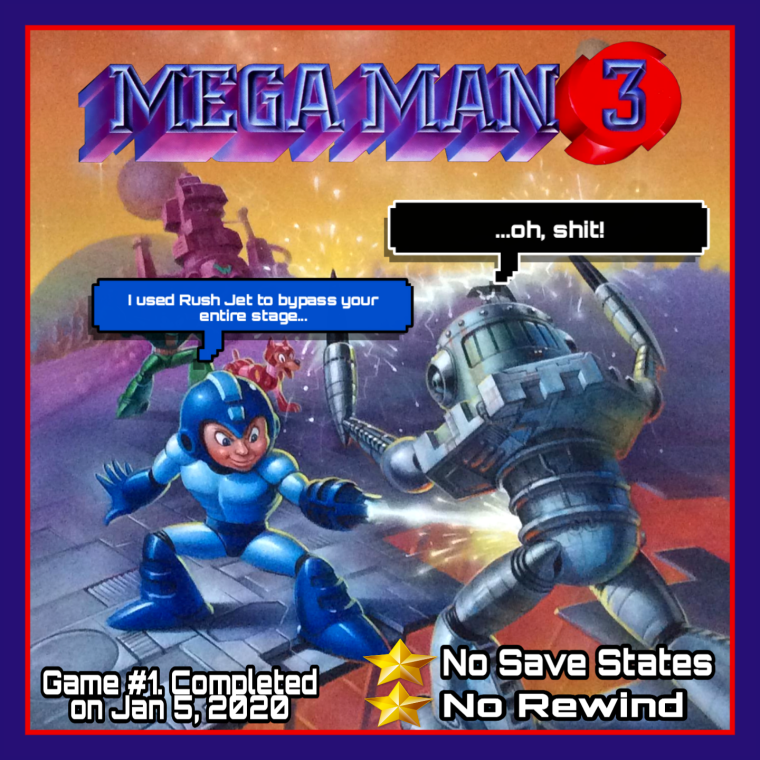
I completed a replay of Mega Man 3 from the Mega Man Legacy Collection for the first time on PlayStation 4 (PS4). I haven’t played MM3 in ages (probably not since the Anniversary collection back on Gamecube), but it was a lot longer than I remembered. MM3 or MM4 was my first MM game, but all of the Blue Bomber’s adventures blur together from my childhood, so it’s hard to recall which one I played first. I replayed MM2 last year, but I couldn’t tell you what was exactly different between the two games. It felt like the stages were shorter in length, but still designed competently and a lot more fair.
It helps that Rush Jet (which I think you unlock based on how many total robot masters you’ve defeated?) trivializes some of the trickier levels. I hardly remember the boss order in any MM game, either. What you think would work against one boss is rarely what’s meant to be used. Outside of trial & error, I almost always end up using the trusty ol’ Mega Buster in the older MM titles, unlike how I typically approach the MMX games. MM3 also has additional bosses beyond the traditional 8 robot masters. There are weird, cloned versions of MM1 and MM2 bosses, which honestly felt like an attempt at padding the game’s overall length. The Wily Castle stages were a lot easier than I was expecting them to be, too.
Now that I’ve started to revisit these games as an adult, I’ve also found myself more engaged/interested in the Mega Man universe, the lore and its attempt at world-building. I love the fact that most of the robot masters were designed for industrial/commercial use. A lot of them have real-world applications, such as Cut Man being used as a means for deforestation or how Top Man is popular around New Year’s because he can produce toy tops for children, but with each iteration (including MM3), some entries seem to have gotten away from that world-view. Like, what purpose does Snake Man serve? Or was he simply designed to target Mega Man? I think I’m overthinking things, haha! At the end of the day, I enjoyed revisiting an important part of my childhood. It’s a great way to start the new year with something short, yet familiar and comforting.
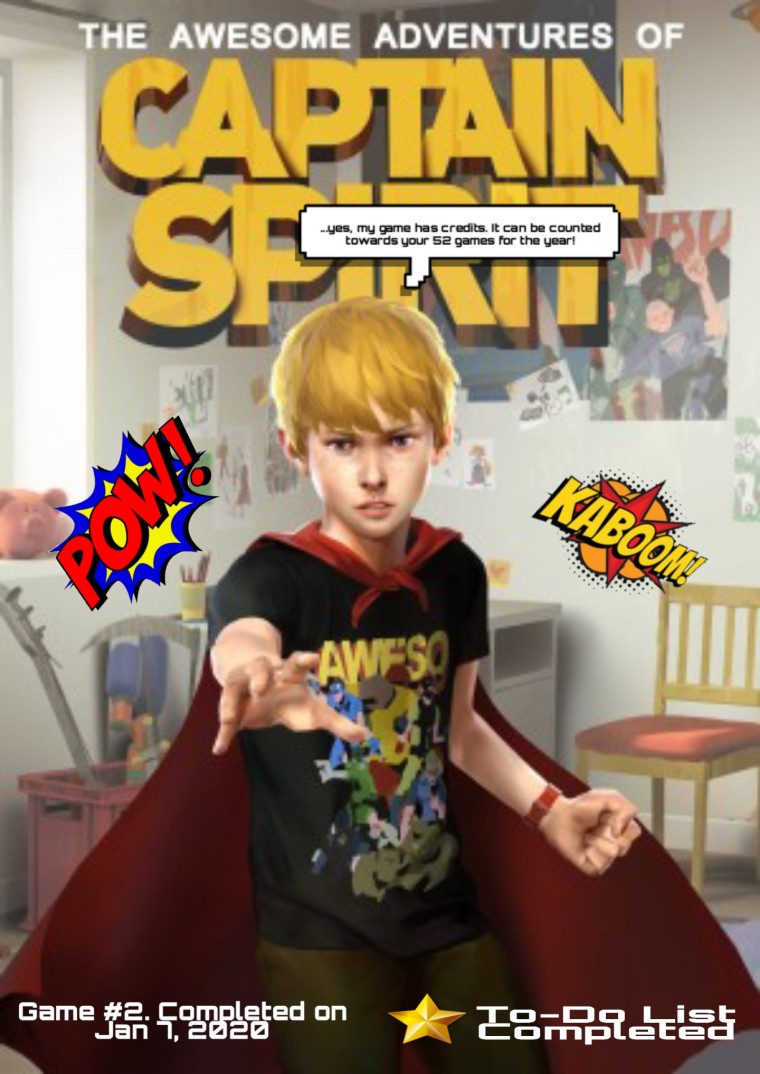
The Awesome Adventures of Captain Spirit, developed by DONTNOD, is a short, free-to-play (F2P) prequel story to Life is Strange 2. Captain Spirit is a story about a single dad raising a young kid with a vivid imagination. If you’ve played Life is Strange (LiS) before, there shouldn’t be many surprises here. For a short prequel episode, Captain Spirit nearly felt like it offered as much content as a full-length LiS episode. There are a decent amount of choices to make and a plethora of objects to interact with, although I couldn’t tell if all of the choices you made had a major impact on the final scene (although, if you shovel the snow off of your staircase and set off the fireworks, these particular events seem to have been referenced, which I’m assuming wouldn’t have been triggered if you didn’t opt to complete these scenes prior).
The best thing about Captain Spirit is seeing the kid’s imagination play out in dramatic cut scenes (such as navigating a dark, maze-like cavern which happens to be just a pile of junk in the front yard or pretending that your dad’s truck is a fully operational spaceship that’s landed on some alien landscape). It’s super endearing and the acting, although sometimes awkward in a Twin Peak’s sort of way, is decent enough. I haven’t played a DONTNOD game since finishing the first LiS well over a year ago, so I really enjoyed my short time spent with this “demo” of sorts. I did manage to finish the game with no hints and with the TO-DO list completed, too. The experience certainly whet my appetite for Life is Strange 2 proper.
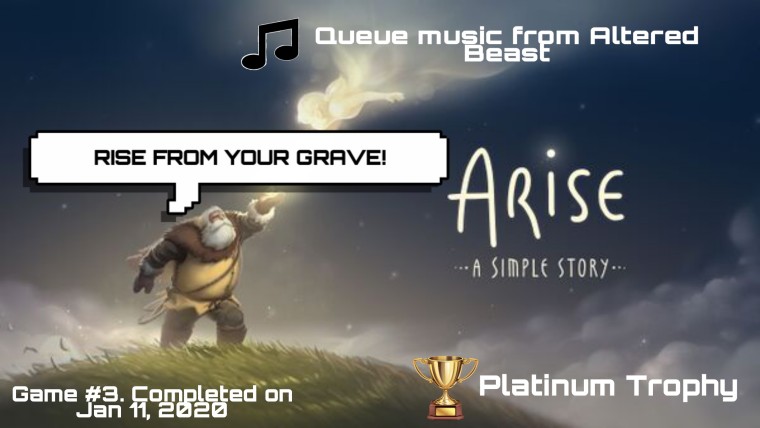
Arise: A Simple Story is a 3D platformer developed by Piccolo, an indie studio out of Barcelona, Spain. It’s a narrative-driven adventure game, not unlike Journey, that tells a tragic story of life, love and loss from what appears to be during the Viking-age. At its core, Arise is a simple puzzle-platformer, however, the game utilizes an interesting mechanic where the player can fast forward/rewind time in order to manipulate the environment. The thing that stood out to me the most about the game was how the developer utilized this simple time-bending mechanic in unique ways. In one stage, manipulating time causes the tides to rise/lower, which allows the player to cross areas which would have otherwise been covered in water. In another level, time can be manipulated in order to spread/douse a wildfire in order to reach areas engulfed by flames. While it’s a mechanic that has been used in countless games before, it’s implemented extremely well here and the developers rarely repeat an idea more than once.
Arise has no dialogue and everything is told through flashback sequences from memories that you can collect throughout its handful of chapters. These scenes are depicted by illustrations which tell the tragic tale of a young tribal boy and girl and their journey through life. While the game is meant to tell an emotional story, it doesn’t quite hit the same marks as say something like Journey, but similar to how I felt about 2019’s Sea of Solitude, perhaps the game will resonate with certain people more than others. One last thing I’ll say about the game is that it’s visually beautiful. It’s a very colorful-looking game and it uses a soft color palette scheme. There’s an almost stop-motion quality to its animations at times, specifically when looking at the environment while you’re fast forwarding/rewinding time, too. I completed the game with 100% of the trophies and it was time well spent.
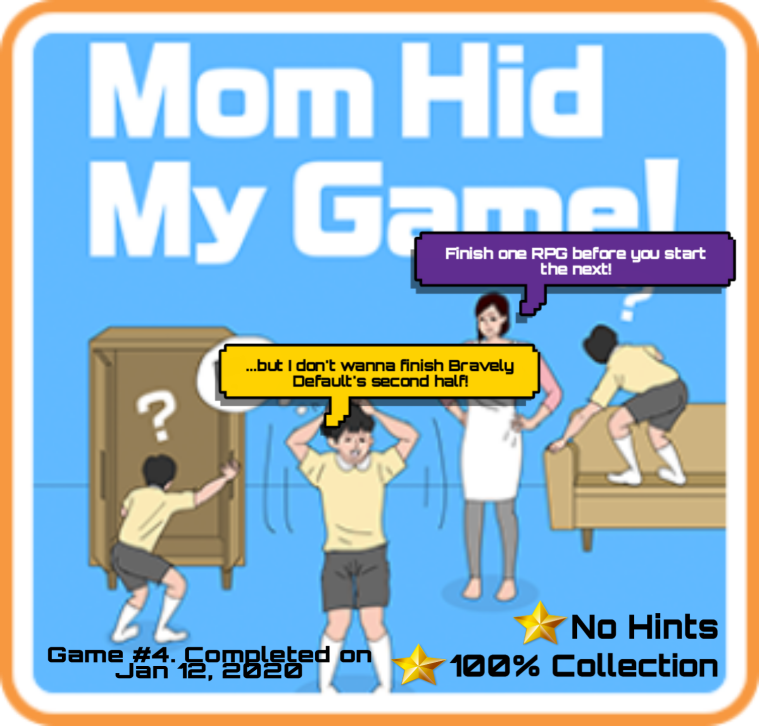
Mom Hid My Game! for the Nintendo Switch is a port of the mobile game developed by Kemco/hap Inc. It’s apparently a “best of” collection based on levels from the mobile games, perhaps with some scenarios exclusive to the Switch version? I’m not entirely too sure. Mom Hid My Game! is a silly point ‘n click puzzle game where a kid must find his portable gaming device (which is very clearly a Nintendo DS) that has been hidden by his mother. Each level presents the player with a ridiculous scenario and in order to obtain the elusive game hidden somewhere in your house, the boy must poke around a variety of rooms while avoiding his mother’s judgment or other ridiculous hazards (such as retrieving the gaming device from an alligator’s mouth or avoiding cyclists who are biking around your living room). The game’s comprised of 50 levels (and a strange mini-game where you collect poses from a gymnast). I completed everything with no hints and even got 100% of the gymnast poses (which was a bit of a grind, but oddly addicting). I’d recommend this only if you’re looking for short sessions between another game’s long loading screens (see Destiny 2 on PS4).

Squidlit, developed by Squidlit Ink LLC, is another short & sweet 2D platformer made specifically with the limitations of the original Game Boy in mind. According to an interview, the developers went to great lengths to capture the specifications of the original Game Boy hardware, including its 4 sound channels, 60 x 144 resolution screen and the system’s inability to display more than 10 sprites in a horizontal line. The game is about as long as the original Kirby’s Dreamland on Game Boy, if not shorter. It’s a pretty straightforward game with very few puzzles, if any. Most of the game has the player simply moving from point A to B, with a few towns to wander through, some NPCs to chat with and a handful of bosses to defeat. Speaking of the bosses, they’re probably the most interesting aspect of the game. One encounter has the player jumping into the pages of a spell-book. By inking certain sections of the book, you can disable certain moves the boss uses. It’s a rather impressive/standout sequence, if you think about it in terms of what the original Game Boy could produce.
It’s also difficult not to compare this game to Save me Mr Tako: Tasukete Tako-San, which released back in 2018. Same me Mr Tako was another Game Boy-inspired 2D platformer where you play as an Octopus. While the later is much more lengthier and robust in terms of features, there’s still something endearing about Squidlit’s simplicity and adherence to its source hardware. As I’ve gotten older, I’ve enjoyed shorter games due to work/life responsibilities, too. If you’re looking for something simple and nostalgic to play in one sitting, you can’t go wrong with Squidlit. I completed the game twice with no deaths on Switch, but unlike the Steam/PC version, there’s very little incentive to replay the game since it’s missing the additional Steam Achievements which might make the experience more worthwhile.

Hi-Bit Studio’s 198X, at first-glance, feels like a downloadable promotional piece that would have launched alongside the release of 2018’s Ready Player One, but it’s certainly much more than that. I’ve said it before, but today’s indie scene is littered with nostalgia-driven throwback experiences. If you were born in the late 80s/early 90s, there’s nearly something for everyone here. There’s a beat ‘em up akin to the classic Streets of Rage franchise, a Gradius-like shmup, a racing game in the vein of OutRun, an auto-runner that’s clearly a homage to the old Shinobi games and even a first-person dungeon crawler reminiscent of the older Phantasy Star games. 198X is more of a narrative-driven experience, however, than the collection of retro-inspired games it appears to be. The game is also a bit of a coming of age story as it tells the tale of what it was like being a nerdy kid in the 80s; having few friends, finding your voice in the arcades, and distancing yourself from society.
198X begins with the Streets of Rage-like title called “Beating Heart”. After a few combat sequences, the game ends with a boss encounter that you can’t even finish, as the screen pans upwards and transitions into a new story vignette before the next title begins. In retrospect, it felt like the developers gave you just enough time to get a feel for the game before they pulled you out of the experience, which can feel somewhat disappointing considering how well made each entry was. Ultimately, each game is essentially a few screens long, but they all feel/play like genuine titles from their respective genres. While it’s also a relatively short game, there are a handful of relatively challenging trophies to pursue, which definitely take a certain degree of mastery to achieve. I completed the game once and earned a few of the trophies and I’ll likely go back for the rest at a later date.
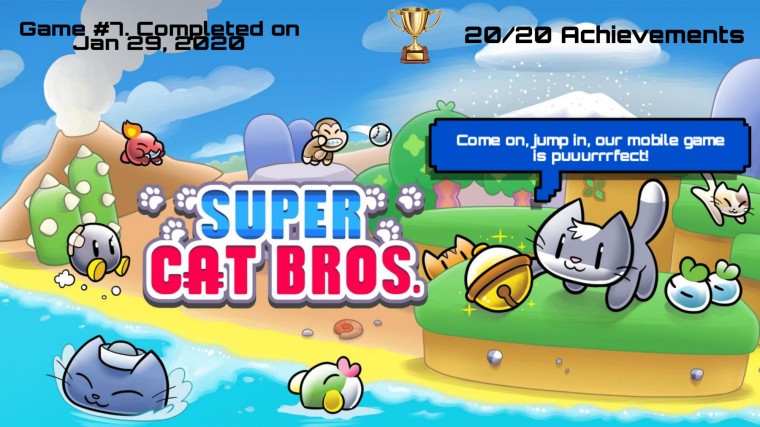
Super Cat Bros., developed by Neutronized, is a 2D platformer for mobile devices. As someone who’s always been skeptical of most mobile games (especially of the F2P kind), I was quite taken back by the quality and competency on display here. Super Cat Bros. is an extremely well-made, bite-sized 2D platformer where you take control of a variety of cats, all of which have their own unique abilities. One cat can climb walls higher than the others while another feline friend can swim. Stages are short & sweet with collectable bells scattered about if you’re looking to get the most of the experience. There’s even secret levels to discover, too. Visually, the game feels like it’s somewhere between a high-end browser/flash game and something that would have felt right at home on the original Nintendo DS.
I’ve also been playing Super Cat Tales II, which is the follow-up prequel/sequel to Super Cat Bros. (yes, there’s an actual story here, complete with cinematic cut scenes and dialogue). The micro-transactions and advertisements are a bit more invasive in the second game than they were in the original, however. After the player completes any stage, you’re asked if you would like to double your collected coins, but only if you watch an advertisement (ad). I can’t believe I’m writing this, but the ads seem to be longer based on how many coins you’ve collected in a stage. Since the game is F2P, they’re also constantly bombarding you to upgrade to the premium package (which essentially means you can play without the ads).
Despite the fact that Super Cat Tales II’s micro-transactions being in the forefront, the sequel feels like a much more realized version of the original game. The developers clearly included what they probably wanted to accomplish with the first game. The backgrounds are more detailed, there’s multiple layers of parallax scrolling, stages are longer (but not too long) and there’s more verticality in the level-design. I’m nearing the end of the game, but I believe it’s still getting updated (perhaps with more levels to explore and cats to play as). With the Switch receiving more and more mobile ports as of late, I wish these two games could receive a collection of sorts on the eShop. They’re extremely well-made 2D platformers that should be played by more people.
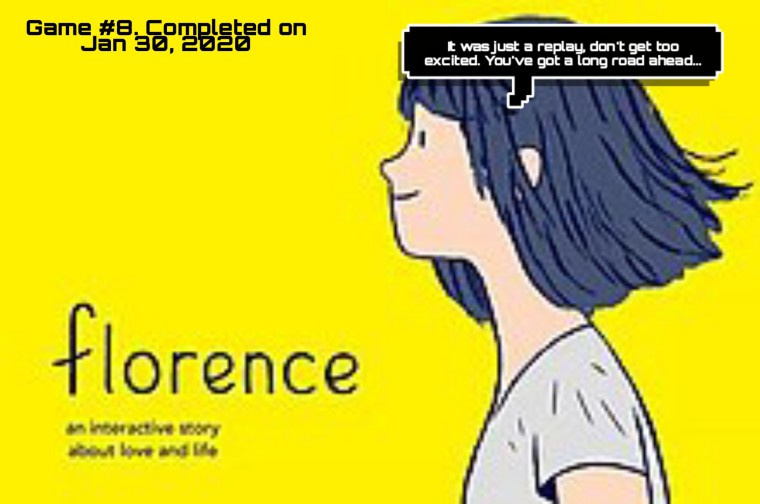
I replayed Florence on mobile during my breaks at work. I’ve written about the game before in the past, but it’s a short, lovely visual novel about the trials and tribulations of adulthood. The game has recently been ported to the Switch, so if you haven’t had a chance to experience this game yet, it’s well worth your time, especially if you’ve ever fallen in (and out of) love with someone.
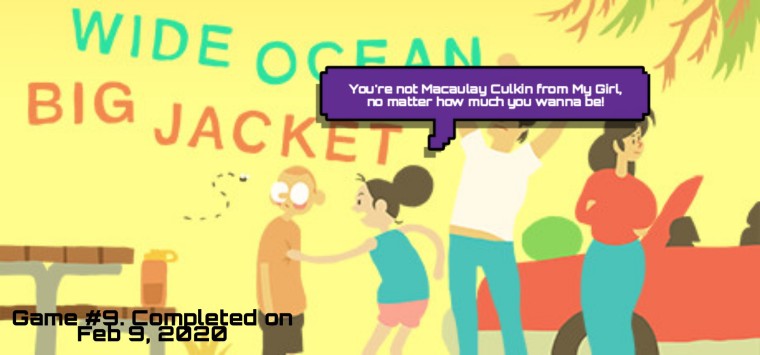
Wide Ocean Big Jacket (WOBJ) is a brief short-story adventure game that focuses on what it means to be young, why growing up sucks and how family trips almost always result in some sort of awkward confrontation. WOBJ is a simple, yet charming game that utilizes basic polygonal shapes, soft colors and excellent writing to tell its story. Outside of walking around, talking to people and moving from one point to the next, there’s very little puzzle-solving here and the experience is more akin to a visual novel than anything. I particularly enjoyed how each character had their own text sound when advancing the dialogue. If you grew up with old Sega games (like Landstalker or Shining Force) or played Undertale or the Yakuza games (if we’re talking about more modern-day examples), you’ll appreciate this little stylistic touch.
The game, at times, also reminded me of 1991’s My Girl, specifically the relationship between the four characters; the boy and girl, Ben and Mord, and the aunt and uncle, Brad and Cloanne, respectively. I couldn’t not think about McCaughley Colkin and Anna Maria Chlumsky’s characters during some of the scenes, specifically when the two are alone. The writing is seriously good and you’ll grow attached to the characters very quickly (specifically during the camp fire scene). WOBJ is the perfect Sunday morning game to play with your morning coffee before you jump back into something a bit more substantial. I completed the game after an hour or two on the Switch.

I first played and completed Sumo Digital’s Snake Pass back on the Switch, but I eventually double dipped on the PS4 version later down the road. I was in the mood for a replay (mostly to hear some of David Wise’s less discussed, but most excellent music contributions) and I fell in love with the whole package again. Snake Pass looks like a mascot era 3D platformer from afar, perhaps even something Rare would have developed back in their heyday, but it’s not quite like anything I’ve ever played. While it’s certainly a collect-a-thon with platforming elements at its core, Snake Pass’s controls and how Noodle (the snake) moves is what differentiates it from its peers. Snakes slither on the ground and are extremely slow, so one can only imagine (if taken to such lengths as they developers did here) how a snake would naturally control in a video game.
With that said, the controls in Snake Pass definitely take a decent amount of time to wrap your head around and some players may be put off by its slow, plodding pace. Once you understand how the mechanics work, however, everything should click. Wrapping yourself around a pole, tightening your grip and just barely sticking your head out to grab a collectable or some sort of lever/switch always felt extremely satisfying. I found myself wanting to dig a little deeper with this replay, so I finally checked out the Arcade mode and Time Trials. The former is a somewhat throwaway experience where you must collect fruit before a timer runs out. While there’s multipliers and incentives to collect fruit in a particular order, there’s no real reward outside logging your best score on a nearly dead leader board.
I found the Time Trials far more engaging as it struck a chord with the speed-running side of my brain. The stages are actually quite competently made, with corners to cut and areas to avoid in order to improve your overall time. As slow as the game is, it’s interesting to see just how quickly the snake can get around the stages, if you know the controls and the layout of the levels well enough. Because the player-base is nearly dead, I found myself somehow placing first on the leader boards, too! Snake Pass is a game I would love to see ran on Awesome Games Done Quick (AGDQ), if it hasn’t been done so already. It’s also a game I would love to see a sequel to as we’re long overdue for a followup.
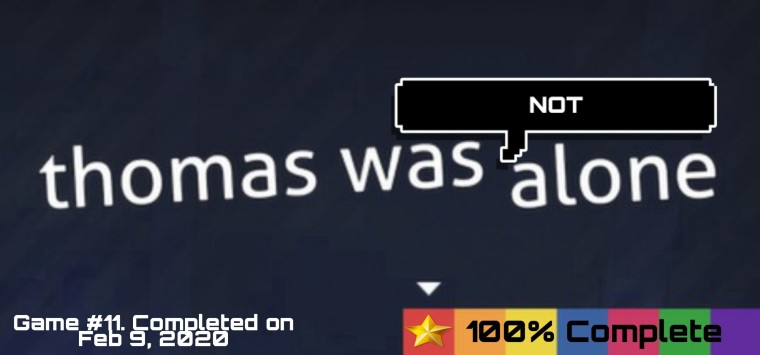
Mike Bithell’s Thomas Was Alone is a 2D puzzle-platformer where the player controls a variety of rectangular shapes, all of which have their own distinct personalities and platforming abilities. One can jump higher than the other while another can float in water, for example, and the goal of the game is to get each block to their designated end-point by assisting each other along the way. It’s a simple concept made better by its charming narration voiced by Danny Wallace (who reminded me of the Little Big Planet narrator at first). Although the game’s sense of humor isn’t exactly my cup of tea, it’s a very well-written, clever game that tells the story about how artificial intelligence can become self-aware and eventually escape its digital confines.
Today, Thomas Was Alone may not be looked back on with the same reverence it received at launch, but along with games like Braid, Super Meat Boy, FEZ, Journey and many others, a lot of these titles have become staples/benchmarks in what is now a thriving independent gaming scene. I’ve stopped/started this game many times over the years, but I finally sat down with it a few months ago and completed the game at 100% with everything collected. I don’t think I’ll ever replay this game anytime soon, but I enjoyed my short time with it nonetheless.
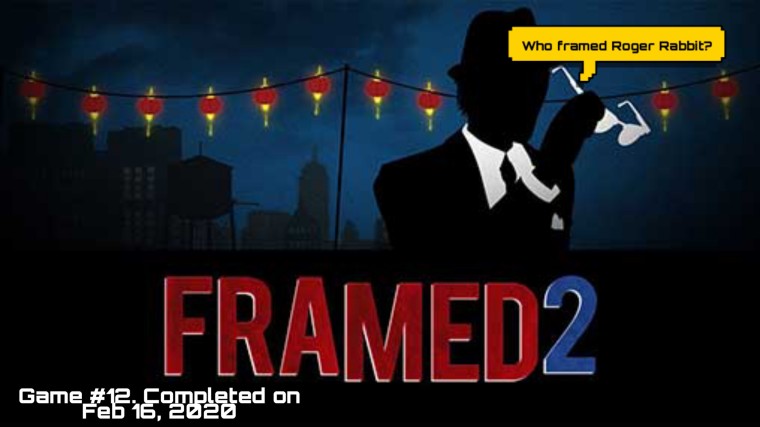
FRAMED 2 (from the FRAMED Collection on Switch), developed by Loveshack Entertainment, is the follow-up to Hideo Kojima’s (of Metal Gear Solid fame) 2014 Game of the Year, FRAMED. FRAMED is essentially an interactive, digital comic book framed (get it) as a video game. You can rotate and manipulate animated panels in order to guide your character through a variety of scenarios. I played the original game a few years ago, so I’m not actually sure what’s different about the sequel other than the fact that it acts as a prequel, in some sense? It’s certainly a smart game with plenty of “aha!” moments once you figure out the puzzle solutions. Both FRAMED games are extremely short and there’s really no incentive to replay them, however. They’re polished, well-made experiences that are worth playing, if you’re looking for a short & sweet brain buster.
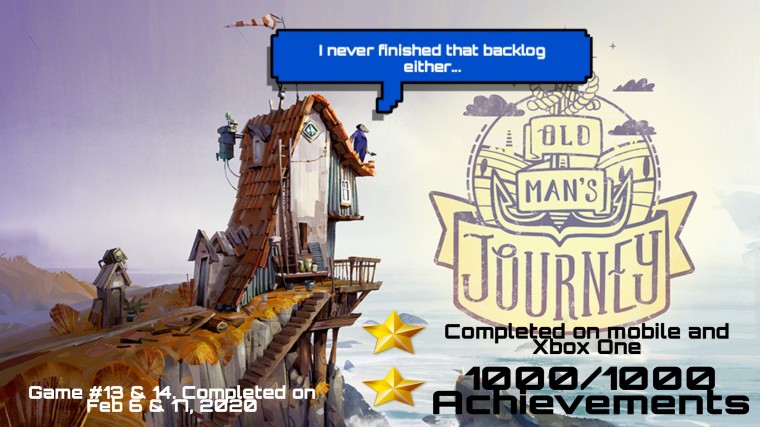
I played and wrote about Broken Rule’s Old Man’s Journey back when I first experienced it on the Nintendo Switch two years ago. Old Man’s Journey is an endearing, yet sometimes sad point ‘n click adventure game about one man’s recollection of life and the choices he’s made (for better or worse). I downloaded the mobile version of the game for my android device and completed another playthrough during my lunch breaks at work. I also downloaded the Xbox One version through Game Pass since the mobile version didn’t have achievements and it’s a slightly different experience. The majority of the game has the player solving simple perspective-based navigation puzzles in the way of pulling/stretching various landscapes in both the background and foreground.
It’s a simple and relaxing experience as you’re essentially creating a path for the old man so that he can reach his next destination. There’s certain obstacles (such as waterfalls and even sheep that must be herd) in order to proceed. As someone who got hooked on Xbox 360 Achievements back in the day, I still find myself appreciating the inclusion of such feats, whether they be PSN Trophies or Steam/Google Play Achievements (for the games that support them, of course). The hardest achievement was easily the one where you had to complete the train sequence without hitting the breaks. Old Man’s Journey on Switch and mobile devices did not have these additional challenges, so for the versions that did include them, they certainly added more replay value to an otherwise short experience.
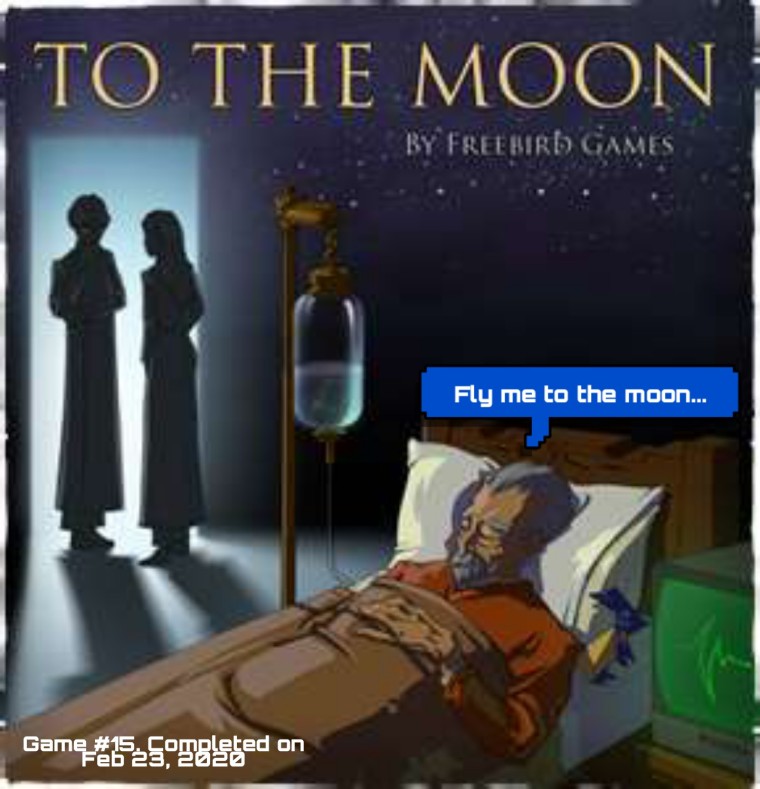
I’ve always wanted to make my own game and while both my brother and I have dabbled with game-making software such as RPG Maker off and on over the years, we could never quite arrive at anything either of us were satisfied with. To the Moon, developed by Freebird Games, is an indie RPG made in RPG Maker XP. It’s essentially a short story about a dying man’s last wish to visit the moon, but there’s much more here than what you might initially suspect. Without spoiling anything, To the Moon is an emotional roller coaster, to say the least. It’s another sad, yet hopeful story about life, love and loss. If you’re even remotely interested in playing this game, it’s better if you go in blind.
While To the Moon looks like a 16-bit era RPG, there’s virtually no combat and it’s more of a text-adventure than anything else. You simply walk around, collecting items/memories to trigger the next story beat while completing strange picture-puzzle mini-games in order to proceed. Although I did tear/choke-up during some of the scenes, I wasn’t always a fan of the writing style, however. There is a certain basement-made feel to the game too, almost as if it’s nearly being held together by worn-out strings, which I appreciated given my experience with using RPG Maker in the past. To the Moon has been around for a long time now and it’s been recently ported to the Switch (where I finally played it). It’s not exactly an enjoyable game, but it’s a story well worth your time if you’re in the right mood.
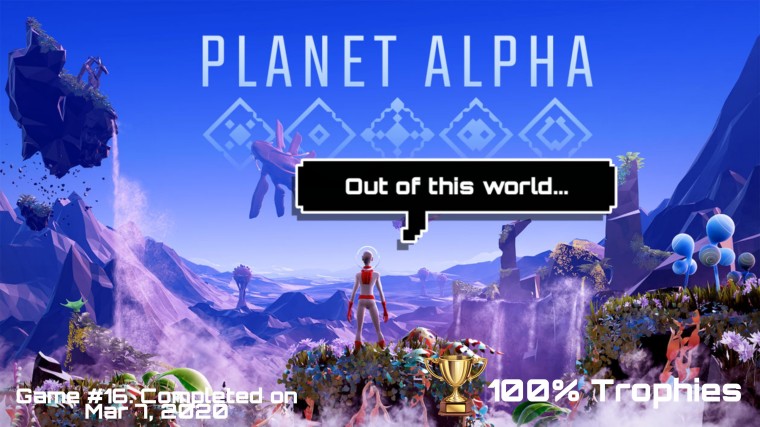
Developed by Planet Alpha ApS, an indie studio from Denmark, Planet Alpha is a 2D adventure-platformer game, not unlike games like Another World (which I also played this quarter for the first time), the original Prince of Persia, Limbo, INSIDE or even the Oddworld games. The most notable thing about Planet Alpha was its otherworldly visuals; whether you’re treated to the exotic flora both in the background/foreground or the strange creatures that inhabit the world, it’s quite the visual tour de force. The game itself plays similarly to the aforementioned titles above, which isn’t necessarily a bad thing.
The game has you simply running left to right, solving mostly basic environmental puzzles by pushing/pulling blocks (which can become a bit excessive), evading robots and other deadly hazards as you progress through its Avatar-like world. There is also a day/night cycle mechanic where the player can manipulate time in order to make progress, but it’s hardly overused. Besides the audio/visuals, my favorite aspect about the game was how there was a persistent threat throughout most of the experience; a giant robot who’s always on your tail, causing problems and impeding your progress, which almost always results in impressive set-piece moments. Planet Alpha certainly didn’t do anything particularly new, but it’s a curious game that doesn’t overstay its welcome.

Adamgryu’s A Short Hike is one of the most enjoyable/pleasant gaming experiences I’ve had all year. I finally installed the Epic Games Store launcher and downloaded the game while it was free a month or two ago. As of March 2020, most people in the United States have finally started to self-quarantine due to a global pandemic. A Short Hike was the perfect example of pure, distilled joy/escapism, as I transitioned to a work from home/lock-down routine. I started the game one Friday night after I logged off of work and finished it after two or three sittings the next afternoon. My first impression of A Short Hike was as if someone took the tutorial/starting island from The Legend of Zelda: Wind Waker and made an entire game out of it.
There’s an immediate sense of discovery/progression here that’s hard to capture, too. Golden Feathers (which, once collected, act as permanent stamina upgrades) allow the player to explore more of the just-big-enough island. The pacing is nearly perfect and the writing is simple, yet charming. It’s also a game that can be beaten within an hour or two, but there’s a decent amount of side activities, secrets to discover and items to collect, if you’re willing to take a detour or two (which you should). It’s a game begging to be played by more people and should b.e ported to more platforms. I completed A Short Hike after 2 hours or so, but there’s some optional content I’ve yet to explore and I’ll most likely return for another short hike or two.
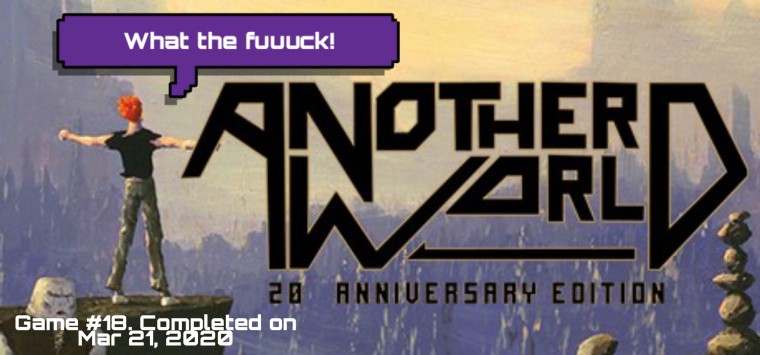
Eric Chahi’s Another World (or Out of This World in other regions) was one of the defining 2D adventure-platformers from its era. As I’ve mentioned earlier in my thoughts on Planet Alpha, much like the original Prince of Persia, Limbo, INSIDE or the Oddworld titles, Another World is about precision platforming and solving cryptic environmental puzzles. With that said, it’s a very particular game, where trial & error trumps any outside-of-the-box idea you may have about proceeding. Perhaps it’s a game that’s showing its age, but I found most of my time spent with Another World to be extremely frustrating, particularly due to the controls (which could be an issue exclusive to the 20th Anniversary Edition) and ridiculous check-pointing.
While the death sequences are varied, unique and entertaining to watch the first time, re watching them for the umpteenth time and getting thrown back to inconsistent/confusing checkpoints wasn’t something I’d consider fun. I hit many roadblocks while playing this game and I didn’t want to look-up solutions if I didn’t have to (yes, I can be very stubborn). Fortunately, I had a friend who played the original version back in the day who happened to remember the solution to a frustrating sequence I was stuck on. In retrospect, Another World was a very short, but aggravating time capsule that would have certainly been impressive for its time. I found myself thinking about replaying Eric Chahi’s spiritual successor/follow-up, Heart of Darkness, instead.
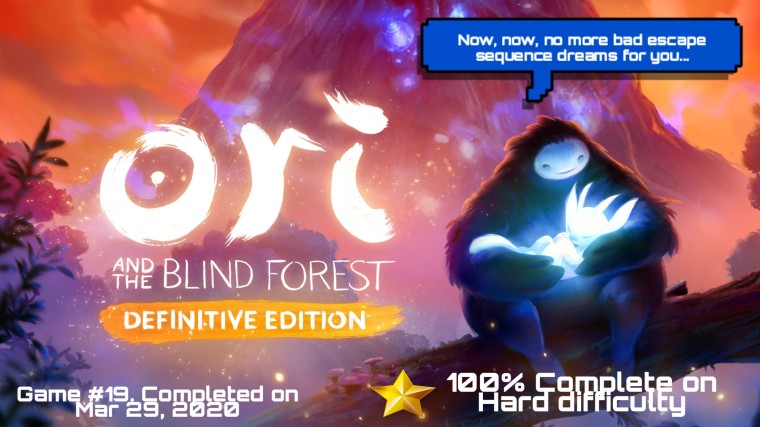
Ori and the Blind Forest, developed by Moon Studios, is one of the more respected/revered modern-day Metroid-likes of our time. I played through the original version back in 2017, but I always wanted to revisit the definitive edition to see what they added before checking out the sequel, Ori and the Will of the Wisps. While it’s mostly the same game with some quality-of-life (QOL) improvements (such as the ability to revisit the main dungeons to collect missed secrets), Ori is still a beautiful, colorful game with a wonderful soundtrack, tight controls and graceful 2D platforming action. It’s also a game that most certainly pulls on the heartstrings, as there’s a much deeper message presented here, one that conveys care, love and respect for all living things.
Ori isn’t always a fun game to play, though. Instead of having traditional boss battles, the developers opted for escape sequences at certain climatic moments in the game. Although these sequences are visually impressive, they can become incredibly frustrating after so many repeat deaths. My biggest issue with the game, however, is how small each character is on the screen. While the game is a sight to behold, sometimes the visuals, both in the background/foreground, gets in the way of the action and makes it difficult to gather your bearings, especially when you’re trying to evade enemy projectiles. There’s also an abundance of cheap deaths, spikes, one-hit kill lasers and other annoying hazards which makes the idea of mastering the game (such as going for a no death run) incredibly demotivating.
With that said, I still really enjoy the first Ori game. I’ve played through both the original game and the definitive edition to 100% completion and for whatever reason, I always feel compelled to keep playing (and that’s more that I can say about other Metroid-likes I’ve started and dropped over the past few years… *cough* Axiom Verge *cough*). I’ve only played an hour or so of the sequel, so I’m hoping Will of the Wisps improves upon the original. but more on that game in a later post…
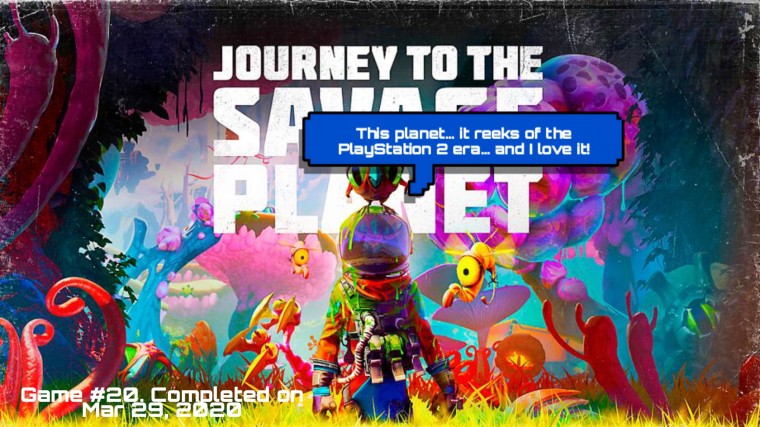
When most people think about indie developers/games or nostalgic throwback experiences, 2D platformers/Metroid-likes are what come to mind. We don’t often get 3D games from independent studios, let alone games that appear to be throwbacks to the types of experiences we’ve had back in the early-to-mid 2000s. Despite being a first-person exploration-based shooter, Typhoon Studio’s Journey to the Savage Planet is probably the most PlayStation 2 era feeling game I’ve played so far in 2020 and the whole experience, quite frankly, was a breath of fresh air. In Savage Planet, Earth has seen better days, so you play as an astronaut sent to an undiscovered planet to explore, catalog and report your findings back to a seemingly nefarious 3rd-rate space exploration corporation.
The narrative is a mixed bag honestly, with its jokey Tim & Eric-like commercials that don’t quite land and its Portal-esque AI that leaves a lot to be desired (who’s also not as funny as Failsafe from Destiny 2). While the humor and lightheartedness may not always work as intended, it’s inoffensive at the very least. The game itself is a lot of fun, though. The sense of exploration, the pacing of upgrades (I usually can’t say no to games with grapple hooks) and the first-person platforming provides an experience that isn’t often available these days. It’s a rather compact journey too, having completed the game somewhere between 8-10 hours, there’s still plenty of secrets to find and multiple endings to discover.

I love launch games. There’s something extremely exciting about playing a brand new game exclusive to a console’s release. Usually, some developers implement a feature, whether graphically or mechanically, that takes advantage of the hardware’s unique capabilities. Housmarque’s RESOGUN was one of the games to pick-up & play back when the PS4 originally launched. Most of Housemarque’s games are finely-tuned, score-chasing arcade affairs and RESOGUN is one of those games that, although short, is meant to be replayed on higher difficulties until you master it (or clear the game in a single credit). I ran through the game a bunch back in the day, but finally completed my first 1CC (single credit) run at the end of March.
At the time, RESOGUN’s voxels (which are essentially pixels that are in 3D) were what set it apart from anything else at the PS4’s release. Clearing the screen with a bomb, defeating a boss and seeing the hundreds of thousands of pixels explode in slow motion was and still is mesmerizing. It’s a shame the developer has abandoned their arcade roots for a battle royale game that may or may not have released? Regardless, I hope with the launch of the PS5 on the horizon, we see developers take advantage of the new hardware’s specs and provide us with something refreshing and unique at the start of the next generation.
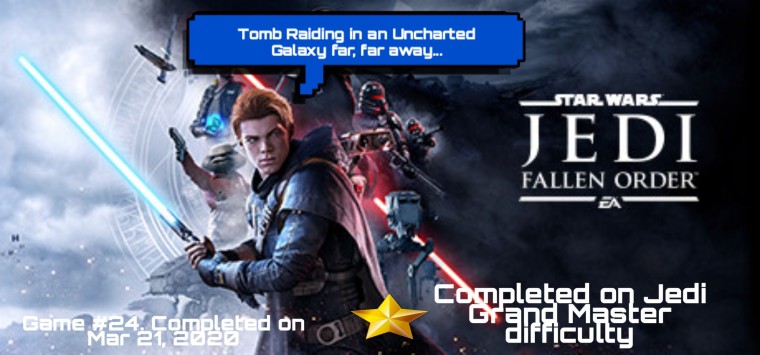
Finally, we’re jumping a bit out of order here, but I completed Respawn Entertainment’s Star Wars Jedi: Fallen Order. I started this game late last year, but finished it on Jedi Grand Master difficulty late in March. I hesitated to count the game towards my goal of 52, but I played the majority of it in 2020, so here we are. If I’m being brutally honest, I’m not the biggest Star Wars fan. I am very neutral towards the entire saga (spin-offs included). I don’t quite remember which trilogy I saw first as a kid too, but I don’t really have any ill will towards any of the movies. Star Wars games, however, have always been as divisive among fans as the movies. Some have aged better than others (such a Knights of the Old Republic and the Rogue Squadron games) while others are best to be left behind in a galaxy far, far away…
I was initially interested in Jedi: Fallen Order because of its developer’s legacy. The director, Stig Asmussen, is known specifically for directing God of War III, but he even worked back on B-tier PS2 era platformers like Dr. Muto (there’s a deep cut for you). Many people have compared the game to From Software’s Dark Souls titles and while there are certainly similarities between the two (such as bonfire equivalents where enemies respawn, a deliberate/thoughtful combat system and experience that must be recovered once you fall in combat), the comparisons end there. Like most Star Wars/licensed titles, games like this often don’t have an identity of their own (not that there’s anything wrong with that). But why not imitate what other successful games do best?
Jedi: Fallen Order is a conglomeration of modern-day game design, for better or worse. It’s got your Uncharted-style story beats, climbing sections and big budget, set-piece moments. You’ve got wall-running and platform sequences reminiscent of the PS2 era Prince of Persia titles (although it’s technically taken from their very own Titanfall franchise) and you’ve got dungeons that could have been optional tombs from the latest Tomb Raider trilogy. With that said, Jedi: Fallen Order is a well-made, competent adventure with planets that are both fun to explore and densely packed with secrets, shortcuts and a variety of combat encounters. By the end of the game, I grew attached to the characters too (although their character models/facial expressions looked strange at times) and it made me want to re-watch the films. I’d gladly take a sequel, but for now, may the force be with your backlog.
See you next quarter!
-Matty
3 Comments »